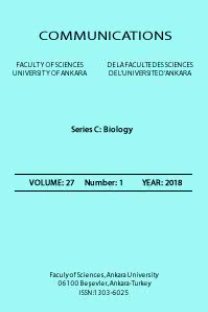ALLERGENIC COMPOUNDS IN HONEY BEE PRODUCTS
Allergy, honey, bee pollen, royal jelly, propolis
___
1 S. Cochrane, K. Beyer, M. Clausen M. Factors influencing the incidence and prevalence of food allergy. Allergy, 64, (2009) 1246–1255.2 H.A. Sampson. Food allergy. Journal of Allergy and Clinical Immunology, 111 (2003) 540–547.
3 J.A. Chapman, I.L. Bernstein, R.E. Lee, J. Oppenheimer. Food allergy: a practice parameter. Annals of Allergy, Asthma & Immunology, 96 (3-Suppl 2), (2006) 1-68.
4 M. Turkalj, I. Mrkic. Alergijske reakcije na hranu. Liječ Vjesn, 134, (2012)168–173.
5 S.L. Taylor, S.L. Hefle. Food Allergies and other food sensitivities. A publication of the Institute of Food Technologists’ expert panel on food safety and nutrition. Food Technology, 55(9), (2001) 68-83.
6 L. Bauer, A. Kohlich, R. Hirschwehr, U. Siemann, H. Ebner, O. Scheiner, D. Kraft, C. Ebner. Food allergy to honey: pollen or bee products? Characterization of allergenic proteins in honey by means of immunoblotting. Journal of Allergy and Clinical Immunology, 97(1), (1996) 65-73.
7 N. Fuiano, C. Incorvaia, G.G. Riario-Sforza, G. Casino. Anaphylaxis to honey in pollinosis to mugwort: a case report. European Annals of Allergy and Clinical Immunology, 38(10), (2006) 364-5.
8 A. Hebling, Ch. Peter, E. Berchtold, S. Bogdanov, U. Müller. Allergy to honey: relation to pollen and honeybee allergy. Journal of Allergy and Clinical Immunology, 97(1), (1996) 65-73.
9 M.F. Martin-Munoz, B. Bortolome, M. Caminoa, I. Bobolea, M.C. Ara, S. Quirce. Bee pollen: a dangerous food for allergic children. identification of responsible allergens. Allergologia et Immunopathologia (Madr.), 38(5), (2010) 263-265.
10 S.H. Cohen, J.W. Yunginger, N. Rosenberg, J.N. Fink. Acute allergic reaction after composite pollen ingestion. Journal of Allergy and Clinical Immunology, 64, (1979) 270–274.
11 J. Bousquet, J. Campos, F.B. Michel. Food intolerance to honey. Allergy, 39, (1984) 73-75.
12 H.K. Güngör, Akyol A. Pathogenesis of chronic urticaria. Turkish Journal of Dermatology, 4, (2014) 223-6.
13 M.I. Fogg, E. Ruchelli, J.M. Spergel. Pollen and eosinophilic esophagitis. Journal of Allergy and Clinical Immunology, 112(4), (2003), 796-7.
14 M. Rosmillah, M. Shahnaz, G. Patel, J. Lock, D. Rahman, A. Masita, A. Noormalin. Characterization of major allergens of royal jelly Apis mellifera. Tropical Biomedicine, 25(3), (2008) 243-251.
15 C. Lombardi, G.E. Senna, B. Gatti, M. Feligioni, G. Riva, P. Bonadonna, A.R. Dama, G.W. Canonica, G. Passalacqua. Allergic reactions to honey and royal jelly and their relationship with sensitization to compositae. Allergologia et Immunopathologia (Madr.), 26(6), (1998) 288-290.
16 S.E. Walgrave, E.M. Warshaw, L.A. Glesne. Allergic contact dermatitis from propolis. Dermatitis, 16(4), (2005) 209-215.
17 C. Gardana, P. Simonetti. Evaluation of allergens in propolis by ultra- performance liquid chromatography/tandem mass spectrometry. Rapid Communications in Mass Spectrometry, 25 (2011) 1675–82.
- ISSN: 1303-6025
- Yayın Aralığı: Yılda 2 Sayı
- Başlangıç: 1943
- Yayıncı: Ankara Üniversitesi
THE ALLERGENIC POLLEN IN THE ATMOSPHERE OF EL-HADJAR CITY (ANNABA, ALGERIA)
Çiğdem ÖZENİRLER, Kadriye SORKUN
CHANGES OF ARTEMISIA POLLEN CONCENTRATION IN ZONGULDAK ATMOSPHERE
Şenol ALAN, Tuğba SARIŞAHİN, Ayşe KAPLAN
URBAN LANDSCAPE AND POLLEN ALLERGY
Çiğdem OZENIRLER, Nazlı MAYDA, Ömür Gencay CELEMLI, Aslı OZKOK, Kadriye SORKUN
POLLEN MORPHOLOGY OF GYPSOPHILA LARICINA L. AND TAXONOMIC IMPORTANCE
İsmühan POTOĞLU ERKARA, Mustafa UYANOĞLU
CHEMICAL COMPOSITION AND ANTIOXIDANT ACTIVITY OF SEVEN DIFFERENT GRAPE EXTRACTS
Laila Radwan Abdalla ELFOGOHI, Haafize Dilek TEPE, İdris YAZGAN, Talip CETER
INVESTIGATION ON POLLEN MORPHOLOGY OF TWO GAGEA SALISB. TAXA FROM TURKEY
Okan SEZER, Ali Can YILDIZ, Onur KOYUNCU, Koray YAYLACI, İsmühan POTOĞLU ERKARA
SPORE MORPHOLOGY OF SOME WEISSIA SPECIES (POTTIACEAE) FROM TURKEY
Merve CAN GÖZCÜ, Güray UYAR, Talip CETER
Tulay Bican SUERDEM, Hanife AKYALCIN, Sunay ALTAN, Melike Nur TOSUN
